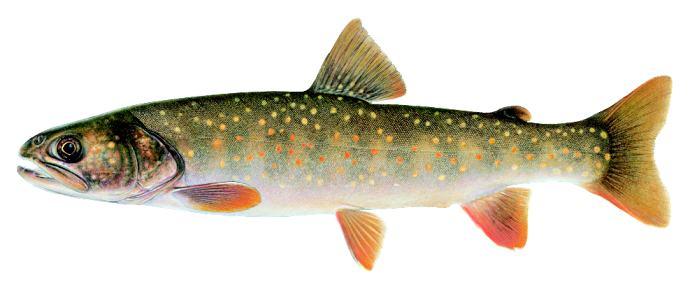Bibliography Background About KRIS
Kootenai River Bull Trout

Bull trout illustration copyright Joseph R. Tomelleri
The bull trout (Salvelinus confluentus) is a close relative of the Dolly Varden (S. malma) and the Arctic char (S. alpinus). The range of the bull trout extends from southern Oregon east into Montana and north to where British Columbia and Alberta border the Yukon Territory.
Bull trout can live from four to ten years of age or more (Behnke, 2002). Several life histories are known for bull trout. Some fish spend their entire lives as residents of headwater streams, where they eat mostly insects and attain a length of only 8-10 inches. Bull trout that dwell in large rivers may grow much larger, 28-36 inches and 10 to 20 pounds, and prefer fish as prey if they are available (Behnke, 2002). These populations may run up smaller tributaries to spawn. Lake dwelling bull trout may grow to be the largest of the species (32 lbs.), particularly when large prey such as kokanee salmon are present. The bull trout spawns in September and October as water temperatures decrease (McPhail and Baxter, 1996). Males develop bright spawning colors and a kype, while females are less colorful.
 Historic range of the bull trout. From Trout and Salmon of North America, R.J. Behnke. 2002. Copyright
Historic range of the bull trout. From Trout and Salmon of North America, R.J. Behnke. 2002. Copyright
According to Behnke (2002): "Bull trout are especially vulnerable to human-induced factors that increase water temperatures and sediment loads, change flow regimes, block migration routes, and establish non-native trout, especially brook trout in streams and lake trout in lakes." The species requires cool water, with preferred temperatures from 50-54 degrees Celsius (10-12 C) and a maximum tolerance of 60 F (15 C). Bull trout are very aggressive, which makes them susceptible to angling.
The KRIS Kootenai Bibliography includes the Montana Bull Trout Restoration Plan (MDFWP, 2000), which targets populations within the Clarks Fork and Kootenai rivers. The goal includes maintaining isolated populations because they represent valuable gene resources and life history strategies. The Plan also calls for maintaining and restoring connectivity of populations. Ultimately the Plan calls for sufficient population health to allow some angling for bull trout.
Paragamian et al. (2001) studied rainbow trout and bull trout recruitment for the Kootenai River in Idaho. They concluded that : "Recruitment of juvenile rainbow and bull trout from Idaho tributaries is not sufficient to be the sole source of subsequent older fish in the mainstem Kootenai River. These populations are at least partly dependent on recruitment from Montana waters."
 This Chart shows spawner survey data collected by the Montana Department of Fish, Wildlife and Parks in the Grave Creek watershed (a tributary to the Tobacco River) for the years 1983-2000. The Chart displays the number of bull trout redds and the number of miles surveyed in each year. Grave Creek tributaries (Blue Sky, Clarence, Williams and Lewis Creeks) are included in the graph. These data are from Hoffman et al. (2002)
This Chart shows spawner survey data collected by the Montana Department of Fish, Wildlife and Parks in the Grave Creek watershed (a tributary to the Tobacco River) for the years 1983-2000. The Chart displays the number of bull trout redds and the number of miles surveyed in each year. Grave Creek tributaries (Blue Sky, Clarence, Williams and Lewis Creeks) are included in the graph. These data are from Hoffman et al. (2002)
Web sites
Fish illustrations by Joseph R. Tomelleri
References
Behnke, R.J. 2002. Trout and Salmon of North America. Free Press, Simon and Shuster, Inc. N.Y., N.Y. 359 p.
Hoffman, G., B. Marotz, J. DeShazer, L. Garrow, T. Ostrowski and J. Dunnigan. 2002. Mitigation for the construction and operation of Libby dam. Annual report, 2000. Montana Fish, Wildlife, and Parks. Bonneville Power Authority project no. 199500400. Portland, OR. 161 pp. [6.9Mb]
Kootenai Tribe of Idaho (KTOI), and G. Krause. 2002. Trout Creek biological assessment: 2001. Prepared for Bonneville Environmental Foundation. KTOI Fish and Wildlife Department. Bonners Ferry, ID. 71 pp. [14.5Mb]
McPhail, J.D. and J.S. Baxter. 1996. A review of bull trout (Salvelinus confluentus) life-history and habitat use in relation to compensation and improvement opportunities. Fisheries management report no. 104. Department of Zoology, University of British Columbia. Vancouver, B.C. 39 pp. [470k]
Montana Department of Fish, Wildlife and Parks (MDFWP). 2000. Restoration plan for bull trout in the Clark Fork River basin and Kootenai River basin Montana. Prepared by the Montana Bull Trout Restoration Team. MDFWP. Helena, MT. As downloaded from: http://www.fwp.state.mt.us/fishing/btroutplan.pdf
Paragamian, V., J.P. Walters, C.C. Downs. 2001. Kootenai River fisheries investigations: Rainbow and bull trout recruitment annual progress report, January 1, 1999- December 31, 1999. Idaho Department of Fish and Game. Report to Bonneville Power Administration (BPA). BPA Report DOE/BP-00004691-1. Portland, OR. 53pp. [660k]
Thurow, R.F. and D.J. Schill. 1996. Comparison of day snorkeling, night snorkeling and electrofishing to estimate bull trout abundance and size structure in a second-order Idaho stream. North American Journal of Fisheries Management. 16:314-323. 10 pp. [472k]
